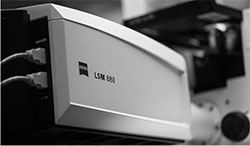Steve Anderson, Ph.D.

Research Physiologist Emeritus
Research Interests
Fluid and electrolyte transport with special emphasis on Na/H and Na/Ca exchange in the heart and Na/H exchange and Na+K+2Cl cotransport in the Blood Brain Barrier. Current studies are aimed at better understanding the role of Na uptake via these transporters in ischemic brain and myocardium as well under conditions of diabetic ketoacidosis. Ongoing studies use magnetic resonance imaging and spectroscopy to assess changes in brain and myocardial Na, pH, Ca, and high-energy phosphates. Diffusion and perfusion weighted imaging are also used to determine cerebral edema and blood flow.
Graduate Group Affiliations
Rutkowsky, J. M., L. L. Lee, M. Puchowicz, M. S. Golub, D. E. Befroy, D. W. Wilson, S. Anderson, G. Cline, J. Bini, K. Borkowski, T. A. Knotts, and J. C. Rutledge. Reduced cognitive function, increased blood-brain-barrier transport and inflammatory responses, and altered brain metabolites in LDLr -/-and C57BL/6 mice fed a western diet. PLOS ONE. 2018 Feb 14;In Press.
Lee, L. L., H. H. Aung, D. W. Wilson, S. E. Anderson, J. C. Rutledge, and J. M. Rutkowsky. Triglyceride-rich lipoprotein lipolysis products increase blood-brain barrier transfer coefficient and induce astrocyte lipid droplets and cell stress. Am J Physiol Cell Physiol. 2017 Apr 1;312(4):C500-C516. PMCID 5407020
Lobo, R. C., N. E. Hubbard, P. Damonte, H. Mori, Z. Penzvalto, C. Pham, A. L. Koehne, A. C. Go, S.E. Anderson, P. M. Cala, and A. D. Borowsky. Glucose Uptake and Intracellular pH in a Mouse Model of Ductal Carcinoma In situ (DCIS) Suggests Metabolic Heterogeneity. Front Cell Dev Biol. 2016 Aug 31;4:93. PMCID 5005977
Ng, K. F., S. Anderson, P. Mayo, H. H. Aung, J. H. Walton, and J. C. Rutledge. Characterizing blood-brain barrier perturbations after exposure to human triglyceride-rich lipoprotein lipolysis products using MRI in a rat model. Magn Reson Med. 2016 Oct;76(4):1246-1251. PMCID 4838551
Walton, J. H., K. F. Ng, S. E. Anderson, and J. C. Rutledge. MRI measurement of blood-brain barrier transport with a rapid acquisition refocused echo (RARE) method. Biochem Biophys Res Commun. 2015 Aug 7;463(4):479-482. PMCID 4552450
Glaser, N., A. Bundros, S. Anderson, D. Tancredi, W. Lo, M. Orgain, and M. O'Donnell. Brain cell swelling during hypocapnia increases with hyperglycemia or ketosis. Pediatr Diabetes. 2014 Nov; 15(7):484-493. PMCID 4104267
O'Donnell, M. E., Y. J. Chen, T. I. Lam, K. C. Taylor, J. H. Walton, and S. E. Anderson. Intravenous HOE-642 reduces brain edema and Na uptake in the rat permanent middle cerebral artery occlusion model of stroke: evidence for participation of the blood-brain barrier Na/H exchanger. J Cereb Blood Flow Metab 2013 Feb;33(2):225-234. PMCID 3564192
Liu, H., P. M. Cala, and S. E. Anderson. Na/H Exchange Inhibition Protects Newborn Heart from Ischemia/reperfusion Injury by Limiting Na+-dependent Ca2+ Overload. Journal of Cardiovascular Pharmacology, 2010 Mar;55(3):227-233.
Yuen, N., S. E. Anderson, N. Glaser, D. J. Tancredi, and M. E. O'Donnell. Cerebral Blood Flow and Cerebral Edema in Rats with Diabetic Ketoacidosis. Diabetes 2008 Oct;57(10):2588-2594.
Medina, D. C., D. M. Kirkland, M. F. Tavazoie, C. S. Springer Jr., and S. E. Anderson. Na+/Ca2+-exchanger-mediated Mn2+-enhanced 1H2O MRI in hypoxic, perfused rat myocardium. Contrast Media and Molecular Imaging 2007 Sep-Oct;2(5):248-257.
Pedersen, S. F., M. E. O'Donnell, S. E. Anderson, and P. M. Cala. Physiology and pathophysiology of Na/H+ exchange and Na+/K+/2Cl- cotransport in the heart, brain, and blood. Am J Physiol Regul Integr Comp Physiol 2006 Jul;291(1):R1-R25.
O'Donnell, M. E., T. I. Lam, L. Q. Tran, S. Foroutan, and S. E. Anderson. Estradiol reduces activity of the blood-brain barrier Na-K-Cl cotransporter and decreases edema formation in permanent middle cerebral artery occlusion. J Cereb Blood Flow Metab 2006 Oct;26(10):1234-1249.
Anderson, S.E., D. M. Kirkland, A. Beyschau, and P. M. Cala. Acute effects of 17ß-estradiol on pH, Na, and Ca and ischemia/reperfusion injury. Am. J. Physiol: Cell Physiology 2005 Jan;288(1): C57-C64.




 Make a donation using our secure online system.
Make a donation using our secure online system.